#napoleon 1955
Explore tagged Tumblr posts
Video
tumblr
Absolutely in love with this scene of the Lefebvres 💖💖💖
#marshal lefebvre#catherine hübscher#françois joseph lefebvre#napoleon 1955#yves montand#patachou#henriette ragon#iam in love with this scene#napoleonic era#napoleon's marshals
147 notes
·
View notes
Text

Inside back cover of Dec 1955 Playboy Magazine
#american culture#playboy magazine#french#napoleon#napoleon bonaparte#illustration#illustrative art#satire#year: 1955
95 notes
·
View notes
Text


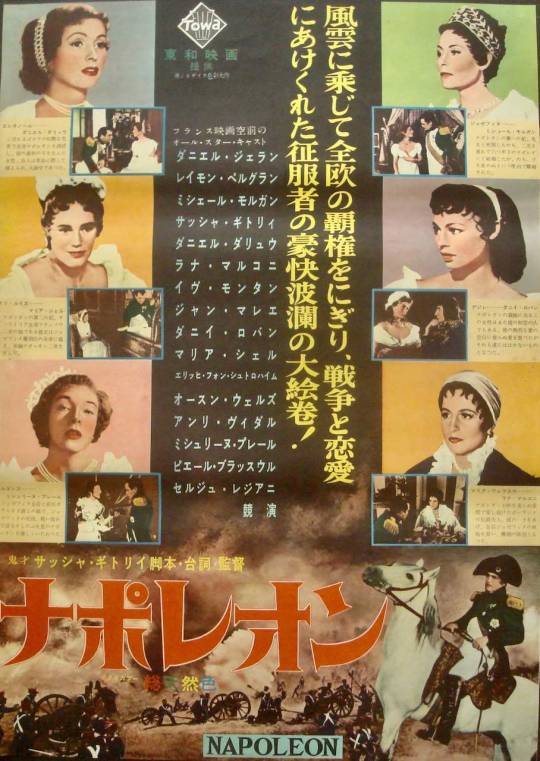
NAPOLEON (1955) - NAPOLEON IN MOVIES (Part 1/10)
As Ridley Scott's napoelon is now out, I thought it would be interesting to have a glance back at several others movies featuring Napoleon Bonaparte, the French Emperor and greatest military tactician of the last 3 centuries, having conquered more land than any other save Genghis Khan, Alexander the Great and the Islamic armies (622 to 73).
While the greatest movie about Napoleon Bonaparte still remains the 6 hour long epic Napoleon vu par Abel Gance filmed in 1922, there are so many movies featuring the French Emperor focusing on his persona, his battles, his family and his romances
We start this 10 Part Blog with an all-star French affair directed by the genial Sacha Guitry who focuses less on the grand scale epics battle sand more on the struggles of a young and an older Bonaparte finding his way to conquer France then Europe while struggling with his libido and doubts
Above are various rare posters from Japan (Click on each image for details).
Director: Sacha Guitry Actors: Jean-Pierre Aumont, Danielle Darrieux, Jean Gabin, Daniel Gelin, Jean Marais, Yves Montand, Michele Morgan, Raymond Pellegrin, Serge Reggiani, Orson Welles
ALL OUR NAPOLEON MOVIE POSTERS ARE HERE
If you like this entry, check the other 9 parts of this week’s Blog as well as our Blog Archives
All our NEW POSTERS are here All our ON SALE posters are here
The posters above courtesy of ILLUSTRACTION GALLERY
#illustraction gallery#illustraction#Napoleon#sacha guitry#Napoleon movies#vintage#film#movies#movie poster#japanese movie poster#1955#Daniel Gelin#Raymond Pellegrin#Jean gabin#Michele Morgan#danielle darrieux#Jean marais
0 notes
Text
Napoleon’s hatred of phrenology and the study of physiognomy
Phrenology: a pseudoscience that involves the measurement of bumps on the skull to predict mental traits.
Physiognomy: the supposed art of judging character or traits from facial characteristics. (Also a synonym for face features or expression)
Phrenology and physiognomy were popular theories during Napoleon’s lifetime which were believed to “establish a scientific and systematic relationship between facial and moral characteristics” (J. Christopher Herold). Napoleon expressed a strong disagreement with these ideas:
“Look at the idiotic theory of Gall [the founder of phrenology]: he attributes to certain prominences [of the skull] tendencies and crimes which are not inborn but which are merely products of society and of human conventions. What would become of the ‘bump of thievery’ if there were no property? What of the ‘bump of drunkenness,’ if there were no alcoholic beverages? What of the ‘bump of ambition,’ if there were no society?”
Source: Profils des contemporains par Napoleon (1824)
“One never must judge a man by his physiognomy. Men must be tested to be known. How many faces I had to judge in my life! What opportunities for acquiring experience! How many denunciations, how many reports have I listened to! And indeed I made it a fixed rule never to allow myself to be influenced either by facial traits or by words.”
Source: Mind of Napoleon: A Selection of his Written and Spoken Words (1955), J. Christopher Herold
“It is a mistake to say that the face is the mirror of the soul. The truth is, people are very hard to know, and yet, not to be deceived, we must judge them by their present actions, but for the present only.”
Source: Napoleon: In His Own Words (1916), Jules Bertaut, as translated by Herbert Edward Law and Charles Lincoln Rhodes
#napoleon#napoleon bonaparte#J. Christopher Herold#Herold#quotes#napoleonic era#napoleonic#first french empire#french empire#quotes by Napoleon#napoleon quotes
153 notes
·
View notes
Text




Marie Louise Duchess of Parma in the 1955 Napoleon Movie
68 notes
·
View notes
Text
THIS DAY IN GAY HISTORY
based on: The White Crane Institute's 'Gay Wisdom', Gay Birthdays, Gay For Today, Famous GLBT, glbt-Gay Encylopedia, Today in Gay History, Wikipedia, and more … December 23



1631 – The English Elizabethan poet Michael Drayton died on this date (b.1563). In 1593 appeared the first of Drayton's historical poems, "The Legend of Piers Gaveston" which dealt with the relationship between the English King Edward II and Gaveston in sympathetic terms that did not condemn their love. Drayton moved in the circle of writers that included Christopher Marlowe and Drayton's play may have had an influence on Marlowe's version which came out the following year in 1594.


1777 – Tsar Alexander I of Russia was born on this date (d.1825). Alexander's Russia is the backdrop for Tolstoy's War and Peace, so complicated is this period of European history. Basically, Alexander may be seen as the emperor of Russia who formed the coalition that defeated Napoleon and founded the Holy Alliance. The church bells you hear at the end of Tchaikovsky's 1812 Overture are ringing out at the news of Alexander's defeat of France, which made him one of the most powerful leaders in Europe.
Is it any wonder Napoleon called Alexander "the slyest and handsomest of all the Greeks," a begrudgingly admiring assessment of the czar's homosexuality, a contention amply supported in the documents of the period. Alexander was always shrouded in mystery. When he died, rumors persisted that he had actually fled Russia to Siberia where he became a hermit. In 1926 his tomb was opened by the Soviet government. It was empty and the mystery remains unresolved.


1954 – Danny Nicoletta is an American photographer, photo journalist and gay rights activist.
Born in New York City, Daniel Nicoletta was raised in Utica, NY. In his late teens he left New York to attend San Francisco State University, later graduating from the bachelor of arts program. He started his photographic career in 1975 as an intern to Crawford Barton, who was then a staff photographer for the national gay magazine The Advocate.
In 1974, when he was 19, Nicoletta first met Harvey Milk and Scott Smith��at Castro Camera, their camera store on Castro Street; the following year, they hired him to work at shop. The three became friends, and Nicoletta worked with Milk on his campaigns for political office. During this period of time, Nicoletta took many now well-known photographs of Milk.

After Milk's death, Nicoletta worked to keep his memory alive. He was the installation coordinator of the Harvey Milk photographic tribute plaques installed at Harvey Milk Plaza and at the Castro Street Station, which featured his photographs as well as those of Marc Cohen, Don Eckert, Jerry Pritikin, Efren Ramirez, Rink, and Leland Toy. He was co-chair of the Harvey Milk City Hall Memorial Committee, and his photograph served as the basis for the bust of Milk that now resides in the rotunda of San Francisco's City Hall.
In the feature film Milk, a biographical film based on the life of Harvey Milk directed by Gus Van Sant, Nicoletta is played by Lucas Grabeel. Nicoletta himself plays Carl Carlson and served as the still photographer on the film.
Nicoletta was one of the founders of the San Francisco International LGBT Film Festival, now known as the Frameline Film Festival. In 1977, while still working at Harvey Milk's photography shop, Nicoletta, along with David Waggoner, Marc Huestis, and others, began film screenings of their Super 8 films, called the Gay Film Festival of Super 8 Films, which evolved into the yearly festival.


1955 – Born: Bill Ryan, in Moncton, New Brunswick. Bill Ryan is a professor of Social Work at McGill University in Montréal, Québec, Canada. He is an international expert in the field of sexuality, sexual education, homophobia, health, and gay men's health.
He is one of the leaders in the international gay men's health movement and has been a driving force behind the transformation of Action Séro-Zéro in Montréal into a full fledged gay men's health organization. In 1992 he was the founding president of the Board of Directors of Séro-Zéro, which was founded to undertake HIV prevention among HIV negative gay men. He returned to the organization in 2000 and has once again been Chair, since 2004.
He is the founder of the Canadian Safe Spaces movement, which, beginning with four sites (Halifax, Moncton, Montréal, Kamloops), has grown into a movement with dozens of supportive services for youth questioning their sexual orientation .
He was founding co-chair of the Canadian Rainbow Health Coalition. In 2006, the Canadian Institutes for Health Research, granted funding to a pan-Canadian team, SVR (Sexuality, Vulnerability and Resilience), of which he is co-chair, to study the impacts of homophobia on the health of gay, lesbian, bisexual, trans and two-spirit Canadians.In October 2009, he was named Personality of the Year by the Conseil Québécois des gais et lesbiennes, and in January 2010 he was awarded the Martin Luther King Junior Legacy Award by the City of Montréal.
Ryan is openly gay. He lives with his partner in Montreal and has an adopted son.


1970 – The film Little Big Man was released on this date. Directed by Arthur Penn, it was one of the year's top grossing films. Of particular interest was actor Robert Little Star's portrayal of "Little Horse", a Transgendered Native American who was well accepted by his peers. This was one of the first popular recognitions of a tradition of sexual diversity among Plains Indian nations.


1980 – Rory O'Malley is an Irish-American film, television, and musical theater actor, best known for his Tony Award-nominated performance as Elder McKinley in The Book of Mormon. He is a co-founder of the gay rights activism group Broadway Impact.
O'Malley was featured in the Dustin Lance Black play, '8', on Broadway as Ryan Kendall and in the Los Angeles premiere as Dr. Gregory M. Herek — witnesses in the federal case that overturned California's Proposition 8.
In 2012, O'Malley and his boyfriend Gerold Schroeder were featured in a GAP ad, cheek to cheek, with the caption "BE ONE."

On July 21, 2013, O'Malley announced that he is engaged to his boyfriend of five years, Gerold Schroeder. On September 28, 2014, Rory and Gerold were married.
O'Malley is an active supporter of gay rights, establishing the activism group Broadway Impact in 2009 with Gavin Creel and Jenny Kanelos. O'Malley said of the group in late 2010:
"[S]ince its first year, Broadway Impact has held massive rallies for equality in New York City, made thousands of calls through phone banks and even organized 25 buses to Washington, D.C. so that 1,400 people could attend the National Equality March for free. This year we were honored to receive the 2010 Human Rights Campaign Community Award and even participated in the ING New York City Marathon as a charity team. Our team of 12 runners, including myself, raised $38,440 for Broadway Impact!"
Openly gay, he came out at the age of 19. In an April 2011 interview with O'Malley said, "Life comes before the business...Maybe some actors haven't gotten a role because they came out, but who gives a shit if you aren't happy? I do have it easier because I'm not a leading man, but I can't imagine having the energy to be in the closet. Besides, gay actors who start up gay organizations can't exactly get away with it." He currently resides in New York City with his husband Gerold. O'Malley remains good friends with Book of Mormon co-star and former college roommate Josh Gad.


1993 – Philadelphia starring Tom Hanks premieres. The film is an American drama and one of the first mainstream Hollywood films to acknowledge HIV/AIDS, homosexuality, and homophobia. It was written by Ron Nyswaner, directed by Jonathan Demme and stars Tom Hanks and Denzel Washington. Hanks won the Academy Award for Best Actor for his role as Andrew Beckett in the film, while the song "Streets of Philadelphia" by Bruce Springsteen won the Academy Award for Best Original Song.


2009 – The Chief Justice of Pakistan orders the National Database & Registration Authority to issue national identity cards showing "distinct" gender allowing hijras to register as a separate gender.


11 notes
·
View notes
Text
Edward Quinn meets Grace Kelly and Prince Rainier of Monaco
I was lucky to have been there when they first met.
During the Cannes Film Festival in 1955, an editorial director of Paris Match, Gaston Bonheur, suggested that a meeting between the Hollywood star Grace Kelly and the bachelor Prince Rainier of Monaco could make a nice story.
When he was asked, Prince Rainier agreed and an appointment was arranged. As I already knew and had photographed Prince Rainier and also Grace Kelly, I was asked by Match to go with their team. There was Pierre Galante, then married to actress Olivia de Havilland, Jean-Paul Olivier and Michel Simon. Grace kept us late, so the American car that was to bring her had to speed off. Just as we got to the main road, the driver, Monsieur Lapinière, a Metro Goldwyn representative, suddenly braked. As I was driving very close, so as not to be left behind, I could not stop and crashed into the back of Grace’s car. Fortunately, there was no great damage and we were able to go on.
As there had been no time for lunch, Grace said she wouldn’t mind having a sandwich, so we went to the bar of the Hotel de Paris in Monte Carlo.

Grace Kelly at the bar of Hotel de Paris.
We got to the palace just after three o’clock, the time set for the rendezvous with the prince. Colonel Severac, the commander of the Palace, came to greet us and explained that Prince Rainier was delayed, but he had telephoned to say that Miss Kelly’s visit to the palace could begin without him. One of Prince Rainier’s personal servants, Michel Demorizi, guided us around some of the great number of rooms in the palace.
In the “Salle du Throne”, Monsieur Demorizi explained that all the reigning princes of the Grimaldi family had been enthroned in this room. We moved through the York Chambers, the “Salle des Glaces” and into the Napoleonic museum, where Grace was obviously impressed when she was shown a lock of Napoleon’s hair. The only one amongst us who did not seem to enjoy the visit was Monsieur Lapinière. It was now nearly four o’clock, and he said that Grace had to leave at once if she was to be ready in time for the official American reception for the festival.
After a while, we all got worried and began to think that Prince Rainier might not come. By now even Grace showed some signs of nervousness, but perhaps not for the same reason. She looked around for a mirror to make sure her makeup was alright. While we all waited, Grace questioned us: How does one address a prince? Could Prince Rainier speak English? How old is he?
Finally, the prince arrived and Grace Kelly, who had rehearsed her royal curtsy several times, hardly bent her knee when she was face to face with Prince Rainier. With a reassuring smile and a simple “Hello, pleased to meet you”, the prince seemed to put Grace at ease.
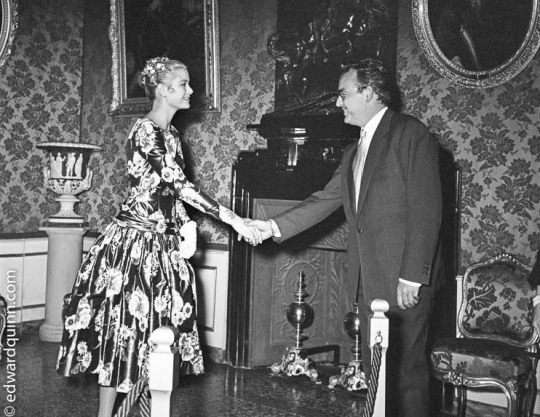
Grace Kelly meets Prince Rainier. The moment of the first formal handshake.
It was amazing, however, that these two famous persons seemed shy and intimidated. Grace looked at Rainier and seemed at loss for words.
Sensing this tension, I thought it might be an appropriate moment to suggest that I would like to take some photos in the palace gardens. This broke the ice. Prince Rainier was relieved and agreed at once. Naturally my main reason for asking them to go outside was just a photographer’s reaction. The light was better outside and of course the garden would make a better setting. Prince Rainier took Grace over to a spot where he could show her the view over his principality. They were both relaxed now. Their conversation became easier and they seemed to be getting on well.
Prince Rainier took Grace down to his exotic gardens and then to his lions’ cage. Grace seemed astonished and quite frightened when Rainier put his arm into the cage and stroked one of the lions. We were all quite happy to prolong this enjoyable visit, but the merciless Monsieur Lapinière seemed on the verge of a nervous fit and kept pointing to his watch. Grace had to take the hint and explained to Prince Rainier that she must go back to Cannes as soon as possible.
Probably not even Prince Rainier realized, while he was doing the honour of showing his palace to Grace Kelly, that she was to be the future sovereign. Grace was quite silent as she was driven back to Cannes. Her only remark was: “He is charming, charming.”
The pictures of Grace Kelly and Prince Rainier appeared in Paris Match, but the story was quickly forgotten by most people, except by Prince Rainier and perhaps by Grace Kelly. Prince Rainier arranged for showings of all of Grace Kelly’s films in his private screening room at the palace. According to his friends, the prince was intrigued and fascinated by the cool enigmatic star from Hollywood.
When Prince Rainier visited the U.S. a few months later, there were a few discreet meetings with Grace Kelly, thanks to the kindly American priest who was Prince Rainier’s palace chaplain, Father Tucker.
Prince Rainier asked Grace Kelly to marry him during a private party in New York. The unofficial news of their engagement travelled very fast and on January 4th, 1956, I was awakened in the middle of the night by a telephone call from New York. At that time long distance calls were still an event. It was Charles Eisnitz of the famous Globe Photo Agency, who called to inform me about Prince Rainier’s engagement and asked me to send all the photos I had of the couple.
The end of the story is well known. After the marriage of Prince Rainier and Grace Kelly, it became more and more difficult to get exclusive pictures. I decided to concentrate my work on the artists, and especially on Pablo Picasso.
Edward Quinn
20 notes
·
View notes
Photo
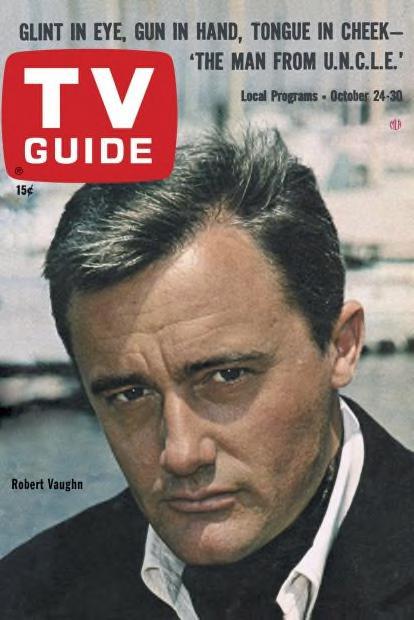
TV Guide - October 24 - 30, 1964
Robert Francis Vaughn (November 22, 1932 – November 11, 2016) Actor noted for his stage, film and television work. His television roles include the spy Napoleon Solo in the 1960s series The Man from U.N.C.L.E.; the detective Harry Rule in the 1970s series The Protectors; Morgan Wendell in the 1978–1979 miniseries Centennial; General Hunt Stockwell in the fifth season of the 1980s series The A-Team; and grifter and card sharp Albert Stroller in the British television drama series Hustle (2004–2012), for all but one of its 48 episodes. He also appeared in the British soap opera Coronation Street as Milton Fanshaw from January until February 2012.
Vaughn made his television debut on the November 21, 1955, "Black Friday" episode of the American television series Medic, the first of more than two hundred episodic roles through mid-2000.
In 1956, Vaughn made his first guest appearance on Gunsmoke in the episode entitled “Cooter.” The following year, he made his second guest appearance on Gunsmoke opposite Barbara Eden in a Romeo-Juliet role, in the episode "Romeo", which turned out okay for the bride and groom.
In 1963 Vaughn appeared in an episode of The Dick Van Dyke Show as Jim Darling, a successful businessman and an old flame of Laura Petrie in the episode "It's A Shame She Married Me". During the 1963–64 season of The Lieutenant, Vaughn appeared as Captain Raymond Rambridge alongside Gary Lockwood, who played a Marine second lieutenant at Camp Pendleton. Vaughn had guest-starred on Lockwood's 1961–62 series Follow the Sun.
From 1964 to 1968, Vaughn played Solo with Scottish co-star David McCallum playing his fellow agent, Illya Kuryakin. This production spawned a spinoff show, large amounts of merchandising, overseas theatrical movies of re-edited episodes, and a sequel, The Return of the Man from U.N.C.L.E.: The Fifteen-Years-Later Affair. (Wikipedia)
IMDb listing
#TV Guide#TV#1964#Robert Vaughn#The Man From U.N.C.L.E.#The Protectors#Centennial#The A-Team#Hustle#Coronation Street
10 notes
·
View notes
Text

Termite Terrace Club - November 26th
1938 - The Daffy Doc - Dir. Bob Clampett
1955 - Heir-Conditioned - Dir. Friz Freleng
TV
1990 - Tiny Toon Adventures Season 1: “Whale’s Tales”
1995 - Pinky and the Brain Season 1: “Napoleon Brainaparte”
2005 - Loonatics Unleashed Season 1: “Sypher”
6 notes
·
View notes
Text
List of Films Turning 20 Years Old in 2024
The Alamo (the one with Dennis Quaid)
Alexander ((the Alexander the Great biopic directed by Oliver Stone and starring Colin Farrell)
Alien vs. Predator
Anchorman: The Legend of Ron Burgundy
The Aviator (the Howard Hughes biopic directed by Martin Scorsese and starring Leo DiCaprio)
Barbershop 2: Back in Business
Before Sunset
Blade: Trinity
The Bourne Supremacy
The Butterfly Effect
Catwoman
Cellular (an action-thriller starring Kim Basinger and Chris Evans)
The Chronicles of Riddick
Closer
Collateral
Dawn of the Dead (the remake directed by Zack Snyder and written by James Gunn)
The Day After Tomorrow
Dodgeball: A True Underdog Story
Downfall
Eternal Sunshine of the Spotless Mind
Fahrenheit 9/11 (the Michael Moore documentary about how the Bush administration handled the aftermath of September 11, as well as their handling of the Invasion of Iraq)
50 First Dates
Finding Neverland (a biopic about J. M. Barrie, the guy who wrote “Peter Pan”. Barrie was played by Johnny Depp)
Friday Night Lights
Garden State
Ghost in the Shell 2: Innocence
Harold & Kumar Go to White Castle
Harry Potter and the Prisoner of Azkaban
Hellboy
Hidalgo
Home on the Range (one of Disney's most often forgotten animated movies)
House of Flying Daggers
Howl's Moving Castle
I Heart Huckabees
I, Robot
The Incredibles
Kill Bill Volume 2
King Arthur (the one with Clive Owen)
The Ladykillers (the remake of the 1955 movie of the same name directed by the Coen Brothers)
Layer Cake (the first movie directed by Matthew Vaughn, who would go on to direct “Kick-Ass” and “Kingsman”)
The Life Aquatic With Steve Zissou
The Lion King 1 1/2
The Machinist (the movie where Christian Bale lost like 60 pounds)
The Manchurian Candidate (the remake of the movie of the same name starring Denzel Washington)
Mean Girls
Million Dollar Baby
Miracle
Napoleon Dynamite
National Treasure
The Notebook
Ocean's Twelve
The Passion of the Christ
The Phantom of the Opera
The Place Promised in Our Early Days (the first film directed by Makoto Shinkai)
The Polar Express
Primer ((the time travel movie where you sit in a box for 12 hours and be back in time 12 hours. I think.)
The Punisher (the Thomas Jane one)
Ray (the Ray Charles biopic)
Resident Evil: Apocalypse
Saw (the 1st one)
Scooby-Doo 2: Monster Unleashed
Seed of Chucky
Lemony Snicket's A Series of Unfortunate Events
Shaun of the Dead
Shrek 2
Sky Captain and the World of Tomorrow
Spanglish
Spider-Man 2
The Spongebob Squarepants Movie
Team America: World Police
The Terminal
13 Going on 30
Troy
Van Helsing
The Village
#dennis quaid#alexander the great#oliver stone#colin farrell#alien vs predator#will ferrell#howard hughes#martin scorsese#leonardo dicaprio#marvel blade#richard linklater#before trilogy#jason bourne#matt damon#catwoman#halle berry#kim basinger#chris evans#vin diesel#riddick#michael mann#tom cruise#dawn of the dead#zack snyder#james gunn#ben stiller#vince vaughn#jim carrey#adam sandler#jm barrie
26 notes
·
View notes
Text
2024 Paralympics 🇫🇷 Versatility is the mantra of wheelchair fencing 🤺
Unlike their able-bodied counterparts, fencers at the Paralympic Games switch between weapons to compete in multiple disciplines, an aspect that presents various challenges. There are three different weapons used in fencing: the foil, épée and sabre - each of which has different compositions, techniques and scoring target areas. All weapons in general, are based on the same basic set of rules making it relatively easy to switch between foil, épée and sabre.
Why is everyone speaking French? 🇫🇷
Like its Olympic equivalent, the official language of wheelchair fencing is French. The referee will say “En garde” ( On Guard, come to the start line), “Prete”(or “Ready” if English), then “Allez” (literally “Go!”; or “Fence if English) to start bouts.🗡️ 🤺 ⚔️
The use of French dates back to the 19th century when Napoleon established fencing as a mandatory discipline in the military. Fencing grew in popularity in France and made its way to the first modern Olympic Games in 1896.
Wheelchair fencing was pioneered about half a century later by Ludwig Guttmann at the Stoke Mandeville Hospital in England UK 🇬🇧 after World War II as part of rehabilitation for patients with spinal cord injuries. It made its Paralympic debut at the inaugural Games in 1960.

Historical, Stoke mandeville games, 1955 two female competitors in wheelchairs taking part in the fencing competition, Stoke Mandeville hospital, Aylesbury, Bucks, England, UK.
Sir Ludwig Guttmann CBE* FRS** (3 July 1899 – 18 March 1980) was a German-British neurologist who established the Stoke Mandeville Games. In September 1943, the British government asked Guttmann to establish the National Spinal Injuries Centre at Stoke Mandeville Hospital in Buckinghamshire. The initiative came from the Royal Air Force (RAF) to ensure the treatment and rehabilitation of pilots with spine injuries, "who often crashed on approach with their bombers damaged".
When the centre opened on 1 February 1944, the United Kingdom's first specialist unit for treating spinal injuries, appointed Guttmann its director (a position he held until 1966). He believed that sport was an important method of therapy for the rehabilitation of injured military personnel, helping them build up physical strength and self-respect.

Sir Ludwig Guttmann and the birth of the Paralympics.
An ever-present in the Paralympic sports programme since Rome 1960, wheelchair fencing is governed by the International Wheelchair & Amputee Sports Federation (IWAS).
The wheelchair fencing competition at the Paralympic Games is in full swing, taking place under the prestigious glass dome of the Grand Palais in the heart of Paris.
📹 Behind the scenes: the process of getting ready for wheelchair fencing 🤺 And yes, well done to the volunteers, well done to the technical Teams.
📹 Passage en coulisses: les détails de la préparation d'une compétition d'escrime fauteuil🤺 Et oui bravo aux Volontaires. Bravo aux Équipes techniques
youtube
*CBE Commander of the Most Excellent Order of the British Empire (CBE)
**FRS Fellowship of the Royal Society (FRS, ForMemRS and HonFRS) is an award granted by the Fellows of the Royal Society of London.
#Paris2024 #wheelchairfencing #Paralympics #escrimepourfauteuil #SirLudwigGuttmann #NationalSpinalInjuries #Buckinghamshire #CentreatStokeMandevilleHospital
Posted 6th September 2024

5 notes
·
View notes
Text

Kiss of Judas. Napoleon Abueva, 1955. Filipino.
This one lives in my head rent-free. This is such an accurate simplification of literally, so many of these Kiss of Judas paintings. It made me laugh in shock the first time I saw it. Abueva, you are so right.
14 notes
·
View notes
Text
"The President will realize what an imbecile he has sent us."

Mind of Napoleon: A Selection of His Written and Spoken Words by J. Christopher Herold, 1955.
9 notes
·
View notes
Text
Subjectively Ranking Most 10 Controversial Artists and the work that enraged the art world: An ‘Ism’ Overview - Perspectives Comparing And contrasting art movements
Marcel Duchamp (1887-1968), Dadaism: His piece, "Fountain" (1917), a porcelain urinal, was seen as a challenge to the conventional notion of what art is and provoked a great deal of controversy.
Damien Hirst (1965- ), Young British Artists (YBA): Hirst's piece "The Physical Impossibility of Death in the Mind of Someone Living" (1991) featured a shark preserved in formaldehyde and received criticism for its perceived lack of artistic merit.
Pablo Picasso (1881-1973), Cubism: Picasso's painting "Les Demoiselles d'Avignon" (1907) was considered shocking due to its distortion of the human form and rejection of traditional perspective.
Jackson Pollock (1912-1956), Abstract Expressionism: Pollock's "drip paintings," such as "Number 1 (Lavender Mist)" (1950), were seen as chaotic and meaningless by some critics.
Gustave Courbet (1819-1877), Realism: Courbet's painting "The Origin of the World" (1866), a close-up of a woman's genitals, was considered pornographic and scandalous.
Edvard Munch (1863-1944), Expressionism: Munch's painting "The Scream" (1893) was seen as disturbing and nihilistic, reflecting the anxieties of modern life.
Francisco Goya (1746-1828), Romanticism: Goya's "The Third of May 1808" (1814) depicted a Spanish firing squad executing citizens during the Napoleonic Wars, challenging traditional heroic portrayals of war.
Kazimir Malevich (1878-1935), Suprematism: Malevich's "Black Square" (1915) was criticized for its rejection of representation and perceived emptiness.
Jeff Koons (1955- ), Contemporary Art: Koons' work, such as his series of sculptures depicting Michael Jackson and his pet monkey, was seen as crass and exploitative.
Caravaggio (1571-1610), Baroque: Caravaggio's violent and dramatic paintings, such as "Judith Beheading Holofernes" (1599-1602), were criticized for their graphic depictions of violence and lack of decorum.
2 notes
·
View notes
Text


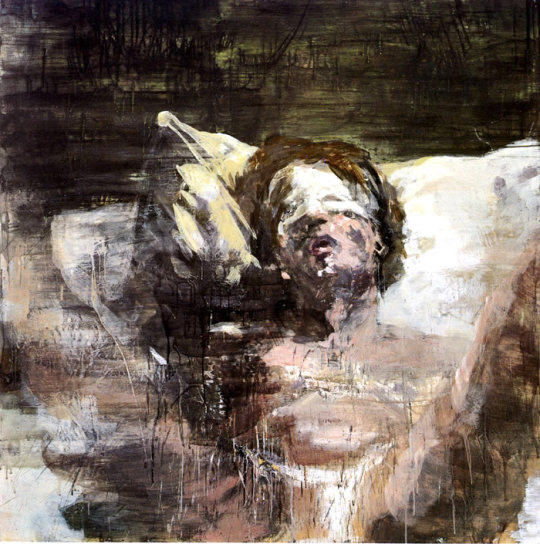
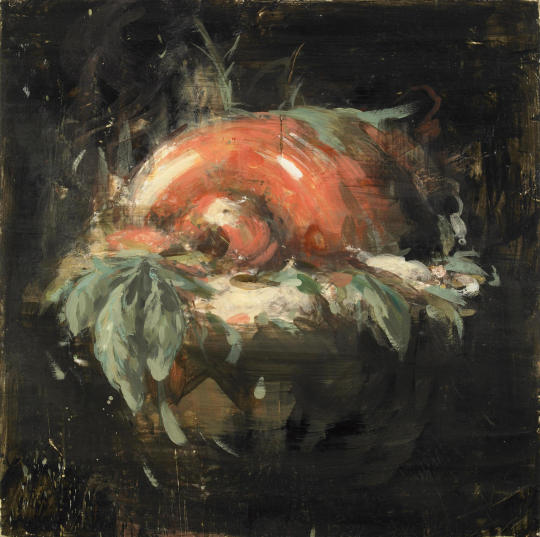
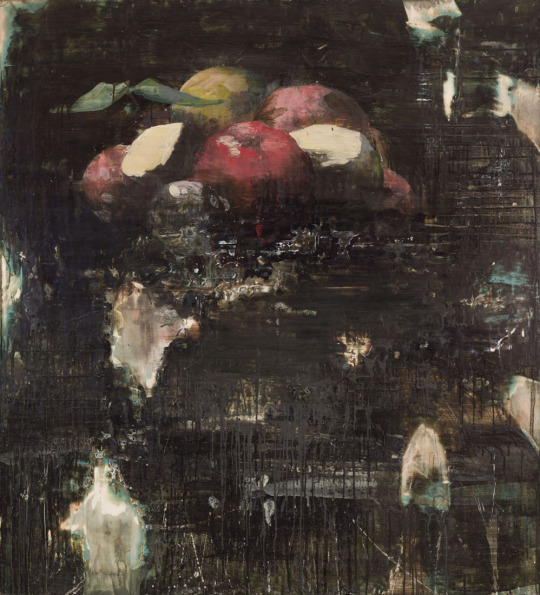
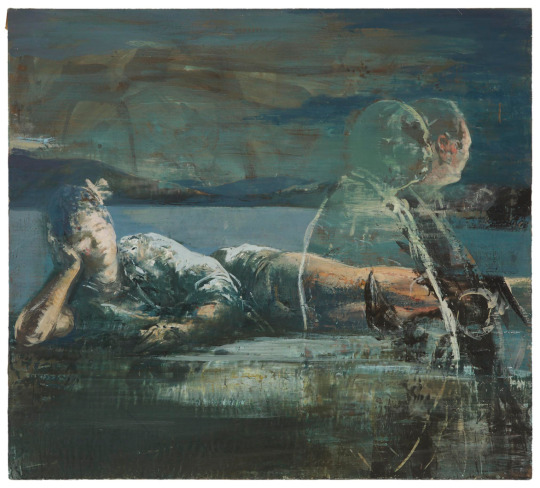
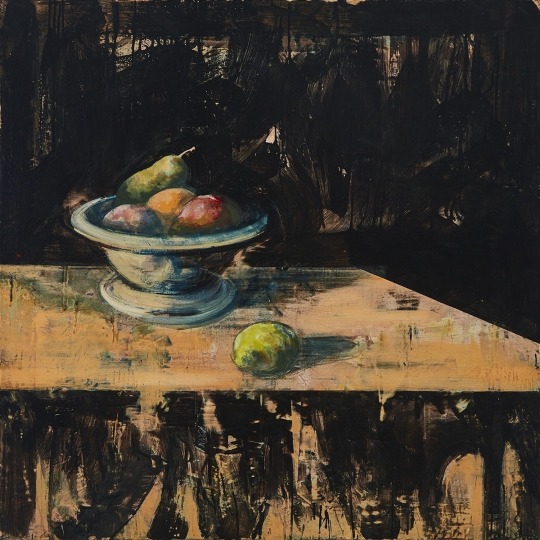
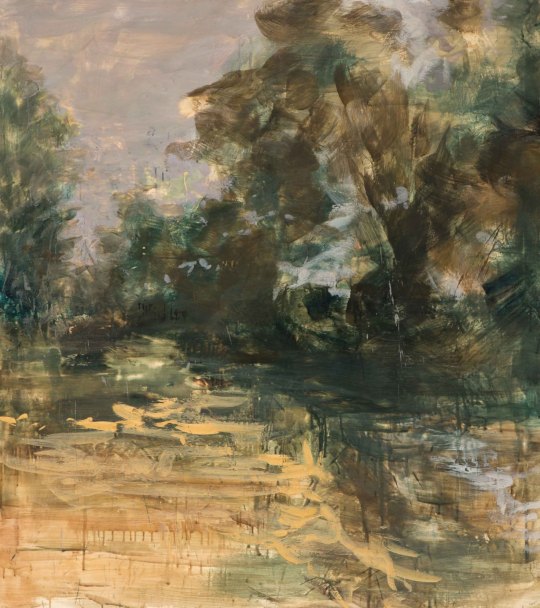


Tony Scherman (born 1950 – Toronto, Canada)
At a time when Pop Art continued to prevail and Conceptualism was on the rise in the 1970s, Tony Scherman chose to pursue image and figuration, working exclusively in the uncommon wax and pigment encaustic technique. His paintings and works on paper weave through the history of art and embrace image-imprints through the modern technologies of camerawork and film. Over the past 30 years, portraiture has become a primary subject matter that are his contemporary meditations encompassing villains and celebrities, bombshells and intellectuals.
Born in Toronto in 1950, Scherman spent his childhood and young adult life in Paris, Europe and then London from 1955. His father Paul was professionally active as a conductor and violinist in Canada, Europe and England. In 1974, Scherman received an MA from the Royal College of Art in London, and returned to Toronto in 1976. He has had more than 100 solo exhibitions across Canada, in the United States and Europe, and in Beijing and Hong Kong. His solo exhibition Chasing Napoleon circulated to six American university museums in 2001-2002.
15 notes
·
View notes
Text
youtube
the goons -- napoleon's piano [11 november, 1955]
3 notes
·
View notes